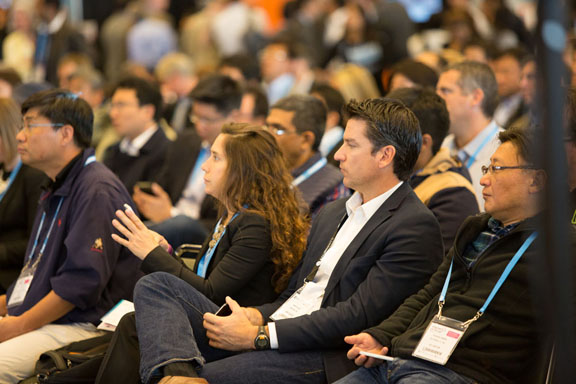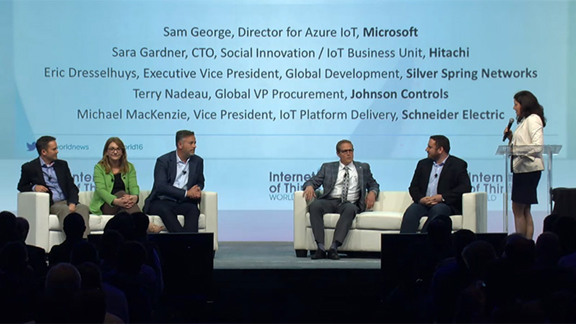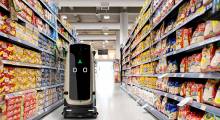 The audience at this year's IoT World Conference (Santa Clara Convention Center, May 10-12) was estimated to be 10,000. It grew rapidly from 750 in 2014 and 5,800 in 2015, according to IoT World founder Gavin Whitechurch. Photo courtesy of IoT World.
The audience at this year's IoT World Conference (Santa Clara Convention Center, May 10-12) was estimated to be 10,000. It grew rapidly from 750 in 2014 and 5,800 in 2015, according to IoT World founder Gavin Whitechurch. Photo courtesy of IoT World.Ushered in by the fast-paced beat of La Roux's “Bulletproof,” Gavin Whitechurch, founder of IoT World, stepped up to the stage to deliver his welcome address. The audience—a stream of IoT believers, investors, and developers—packed the ballroom.
“It’s been an amazing journey over 3 years,” said Whitechurch. “We started three years ago on a street in Palo Alto. We set it up for 350 people, but actually got 700. Last year, in San Francisco, it was 5,800. And here, we’re expecting 10,000 people. That shows you the amazing growth of the IoT space. In the next years, you’re going to see many enterprise deployment of IoT.”
IoT World Conference is produced by Informa, a publishing and event production company. This year's IoT World (May 10-12) took place in Santa Clara Convention Center, California. The show's sponsors for 2016 included Microsoft, Hitachi, SAP, HP, and Avenet. Executives from the sponsoring tech giants joined the onstage discussions, their enthusiasm tempered with concerns for the unknowns in IoT.
Industrial IoT
In “Examining the Industrial IoT Opportunities,” a panel moderated by mobile market analyst Maribel Lopez (Lopez Research), Sara Gardner, CTO of Hitachi's IOT business unit, identified “the human-machine interaction” as “an extremely important area for IoT innovation.”
Sam George, Microsoft's director for Azure IoT, added, “Safety is another area of importance. There are some straightforward things to do, also some far-out things. For example, using [VR headgear] Hololens in industrial IoT to visualize safe zones or perform remote fixes.”
Michael MacKenzie, Schneider Electric's VP of IoT, said, “We have been connecting things for a long time in industrial automation. But the difference now is the scale and speed at which we can deliver it. IoT as a multi-site, multi-tenant application accelerates everything, from message passing to business processes.”
 Panel discussion on industrial IoT opportunities. Photo from IoT World event videos.
Panel discussion on industrial IoT opportunities. Photo from IoT World event videos.GPU-Accelerated Machine Learning
Previously, Andrew Cresci managed NVIDIA's GRID product line, essential to the GPU maker's penetration into the virtualization and high-performance computing (HPC) markets. Today, he is NVIDIA's GM of industrial sector, responsible for IoT strategies and alliances.
“The primary customer engagement for us will probably be around machine learning,” he revealed. “The issue that everybody is facing in IoT is the huge amount of data from the sensors. A train, as I've heard, collects thousands of data points per second, but only uses about three to make decisions. The Holy Grail for this industry is predictive maintenance. Today, people use statistical techniques to anticipate what might go wrong or break. What we see is, in certain fields, deep learning can yield insights and predictions far better than humans can.”
NVIDIA's interest rests with GPU-accelerated deep learning—the use of GPU-equipped servers to compute, analyze, and predict events, like engine failure and plant downtime. The company has proven with its work in the autonomous vehicle sector that GPU-accelerated image processing—the foundation technology in automatic navigation and decision making—works well. It now seeks to apply the same approach to find useful patterns and insights from the vast volume of sensor output, a consequence of the consumers' reliance on connected devices.
At the recent NVIDIA GPU Tech Conference, NVIDIA launched DGX-1, a hardware offering for machine learning and neural network development. According to NVIDIA, the DGX-1 software stack “includes major deep learning frameworks, the NVIDIA Deep Learning SDK, the DIGITS GPU training system, drivers, and CUDA for rapidly designing deep neural networks (DNN).”
Describing its database and visual analytics platform, MapD writes that it “harnesses the parallel power of GPUs to let you explore multi-billion row data sets in milliseconds.” GPUdb, a company that sets out to tackle “some of the most challenging Big Data problems,” also writes that it “exploits the power of massively parallel graphics processing units.”
AI to Define the New Normal
In the same week of IoT World conference, PTC released a new version of its IoT platform, ThingWorx. Part of the new ThingWorx 7 is ThingWorx Analytics, an AI-like feature that can crunch data and learn what's “normal” for a set of devices. The product has three major components:
- ThingWatcher, which finds anomalies in edge devices in real-time;
- ThingPredictor, which automatically predicts outcomes;
- ThingOptimizer offers remedies and simulations to improve product performance.
“Think of it not just as an algorithm, but algorithm that can coordinate different algorithms,” said Rob Patterson, PTC's VP of product marketing, technology platform group. “The AI technology built into ThingWatcher shrinks the machine-learning ability to a small kernel, and sends it to the edge devices to learn what 'normal' looks like. If the so-called 'normal' changes, it can retrain itself to understand the new normal.”
With classic analysis software like PTC Creo Simulate, PTC has a history in the pre-production phase. With products like ThingWorx Analytics, the company is carving out a space in the post-production, after-market commerce. In this sector, the ability to anticipate product failures and offer preventative maintenance is a competitive advantage.
AI-Assisted Data Dig
In IoT, hardware and software—two components that previously existed in different universes—must work in concert to produce an experience. The marriage of the two is not always as smooth as some would like it to be.
In the panel on industrial IoT opportunities, Schneider Electric's Michael MacKenzie revealed, “Some of our business are Things. We also have our software business line. Bringing the Things and the software together is actually more challenging than we'd expected in the beginning.” The IoT consumers also flout the traditional sales transactions, demanding instead what Microsoft's Sam George described as “Thing as a service.”
For software vendors in enterprise data management, IoT's Big Data is a double-edged sword. The vast amount of sensor data from the devices threatens to break the traditional database architecture. At the same time, it offers tantalizing business opportunities with additional insights. Harvesting patterns of consumer behaviors, usage records, and device performances is beyond the scope of traditional product lifecycle management (PLM) or enterprise resource management (ERP).
PLM, ERP, and business analytics solutions help you if you know what you're looking for. In IoT, you don't always know what you're looking for. AI, some hope, will be able to identify the precious nuggets buried in the binary code.
About the Author
Follow Robotics 24/7 on Linkedin
Article topics
Email Sign Up
















